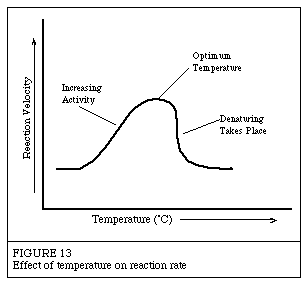Introduction to EnzymesThe following has been excerpted from a very popular Worthington publication which was originally published in 1972 as the Manual of Clinical Enzyme Measurements. While some of the presentation may seem somewhat dated, the basic concepts are still helpful for researchers who must use enzymes but who have little background in enzymology. Temperature Effects Like most chemical reactions, the rate of an enzyme-catalyzed reaction increases as the temperature is raised. A ten degree Centigrade rise in temperature will increase the activity of most enzymes by 50 to 100%. Variations in reaction temperature as small as 1 or 2 degrees may introduce changes of 10 to 20% in the results. In the case of enzymatic reactions, this is complicated by the fact that many enzymes are adversely affected by high temperatures. As shown in Figure 13, the reaction rate increases with temperature to a maximum level, then abruptly declines with further increase of temperature. Because most animal enzymes rapidly become denatured at temperatures above 40°C, most enzyme determinations are carried out somewhat below that temperature. Over a period of time, enzymes will be deactivated at even moderate temperatures. Storage of enzymes at 5°C or below is generally the most suitable. Some enzymes lose their activity when frozen. Next: Effects of pH |

 Place Order
Place Order PDF version of Introduction to Enzymes
PDF version of Introduction to Enzymes